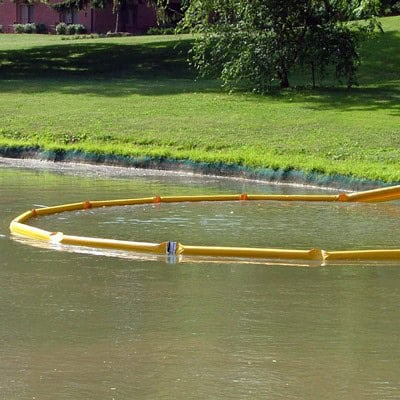When dealing with environmental emergencies like oil spills, time is of the essence. Quick and effective response can mean the difference between a minor incident and a major environmental disaster. One of the most effective tools in the arsenal of emergency responders is the spill containment boom. In this article, we will explore what spill containment booms are, how they work, and why they are essential in emergency response situations.

What Are Spill Containment Booms?
Spill containment booms are long, floating barriers used to contain oil or other hazardous materials on the water’s surface. They are designed to prevent the spread of oil spills, keeping the spill contained to a specific area and making cleanup more manageable. These booms are crucial for protecting shorelines, wildlife, and delicate ecosystems from the harmful effects of oil spills.
Types of Spill Containment Booms
There are several types of spill containment booms, each designed for specific conditions and types of spills:
- Fence Booms: These are used in calm waters. They have a solid construction, which makes them effective at containing spills but less flexible in rough conditions.
- Curtain Booms: Designed for use in open water, curtain booms have a flexible skirt that can adapt to waves and currents.
- Inflatable Booms: These are portable and easy to deploy, making them ideal for rapid response situations. They can be inflated on-site and are suitable for both calm and rough waters.
- Fire Booms: Used for in-situ burning of oil spills, these booms are heat-resistant and allow for the controlled burning of oil on the water surface.
How Do Spill Containment Booms Work?
Spill containment booms work by creating a barrier that prevents oil from spreading. The boom floats on the water’s surface, with a portion submerged to block the oil from passing underneath. Here’s a step-by-step look at how these booms are used in an emergency:
- Deployment: Booms are quickly deployed around the spill area. This is often done using boats, and the booms are anchored in place to prevent them from drifting.
- Containment: Once in place, the booms contain the oil within a specific area. This prevents the spill from spreading and allows for easier cleanup.
- Collection: With the oil contained, recovery teams can use skimmers or other equipment to collect the oil from the water’s surface.
- Disposal: The collected oil is then disposed of according to environmental regulations.
Importance of Spill Containment Booms in Emergency Response
Spill containment booms are an essential component of any emergency response plan for oil spills. Here are some reasons why they are so critical:
Rapid Response
In the event of an oil spill, time is of the essence. The quicker the response, the less damage an oil spill can cause. Spill containment booms can be deployed rapidly, allowing responders to quickly contain the spill and minimize its impact.
Protection of the Environment
Oil spills can have devastating effects on the environment, killing wildlife and damaging ecosystems. By containing spills quickly, booms help protect shorelines, marshlands, and other sensitive areas from contamination.
Cost-Effective
While the initial investment in spill containment booms can be significant, they are a cost-effective solution in the long run. By preventing the spread of oil and reducing the need for extensive cleanup efforts, these booms can save money and resources.
Versatility
Spill containment booms are versatile and can be used in various environments and conditions. Whether it’s a small spill in a calm harbor or a large spill in rough seas, there is a boom designed for the situation.

Real-Life Applications of Spill Containment Booms
Spill containment booms have been used in numerous real-life scenarios to prevent environmental disasters. One notable example is the Deepwater Horizon oil spill in 2010. During this catastrophic event, miles of containment booms were deployed to protect the Gulf Coast’s beaches and marshlands from oil contamination. While the spill was enormous and challenging to manage, the use of booms helped reduce the environmental impact.
Best Practices for Using Spill Containment Booms
To ensure the effectiveness of spill containment booms, it’s crucial to follow best practices in their deployment and use:
- Training: Emergency responders should be trained in the proper deployment and use of spill containment booms. This ensures a swift and effective response in the event of a spill.
- Maintenance: Regular inspections and maintenance of booms are essential to ensure they are in good condition and ready for use when needed.
- Coordination: Effective communication and coordination among response teams are vital for the successful use of spill containment booms. This includes working closely with local authorities, environmental agencies, and other stakeholders.
- Evaluation: After an incident, conducting a thorough evaluation of the response efforts can help identify areas for improvement and ensure better preparedness for future spills.
Conclusion
Spill containment booms are an indispensable tool in emergency response efforts for oil spills. Their ability to contain and control spills quickly and effectively makes them a critical component of any oil spill response plan. By investing in the right equipment and training, emergency responders can better protect the environment and minimize the impact of oil spills on our planet. Whether used in calm waters or rough seas, spill containment booms are a key line of defense against environmental disasters.
Shop at Absorbents Online for Spill Containment Solutions
Don’t wait for an emergency to prepare! Equip yourself with the best spill containment solutions available at Absorbents Online. Our range of high-quality spill containment booms and accessories ensures you are ready to respond effectively to any spill situation. Visit our website today to explore our products and safeguard the environment with reliable containment solutions!